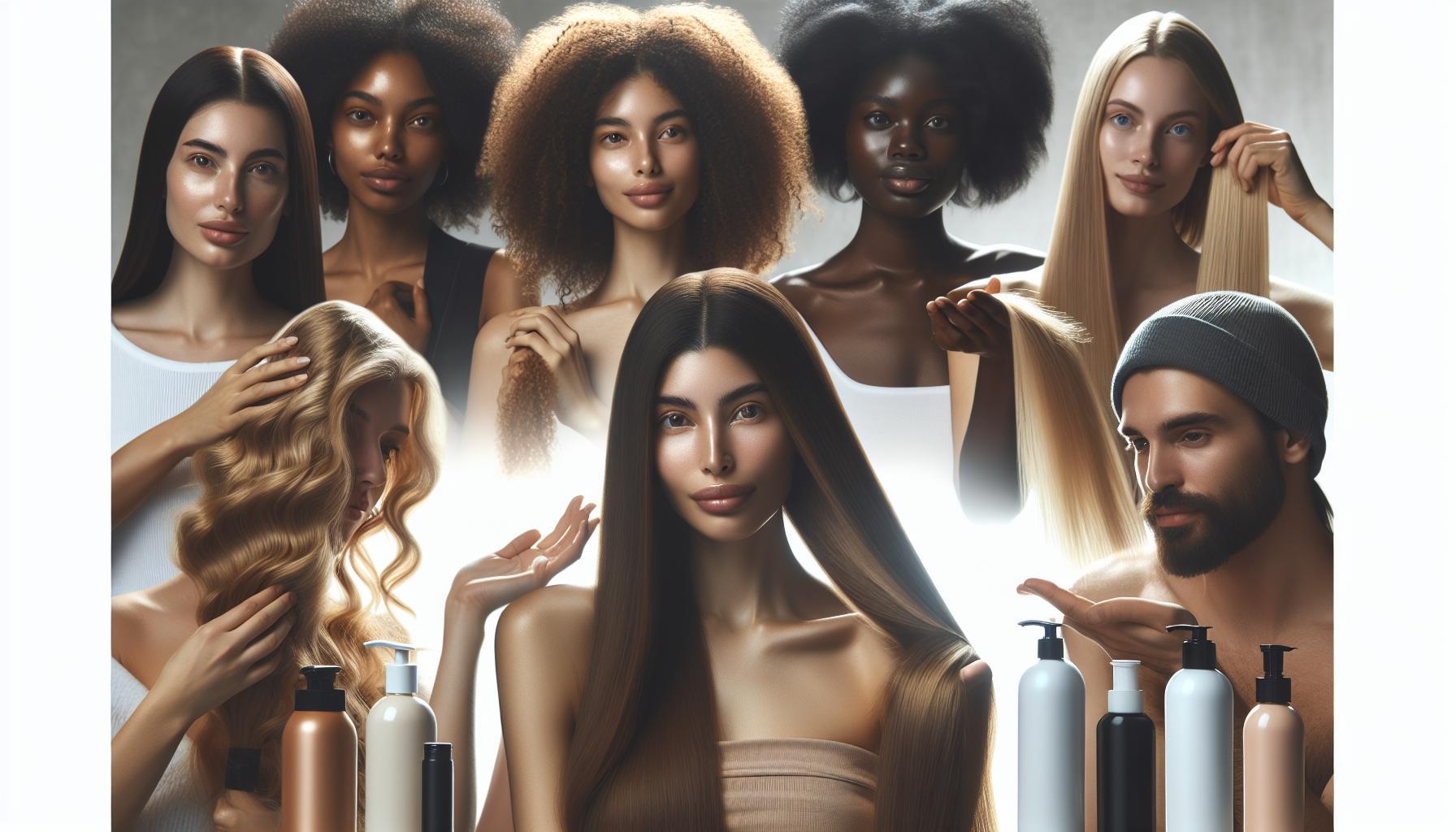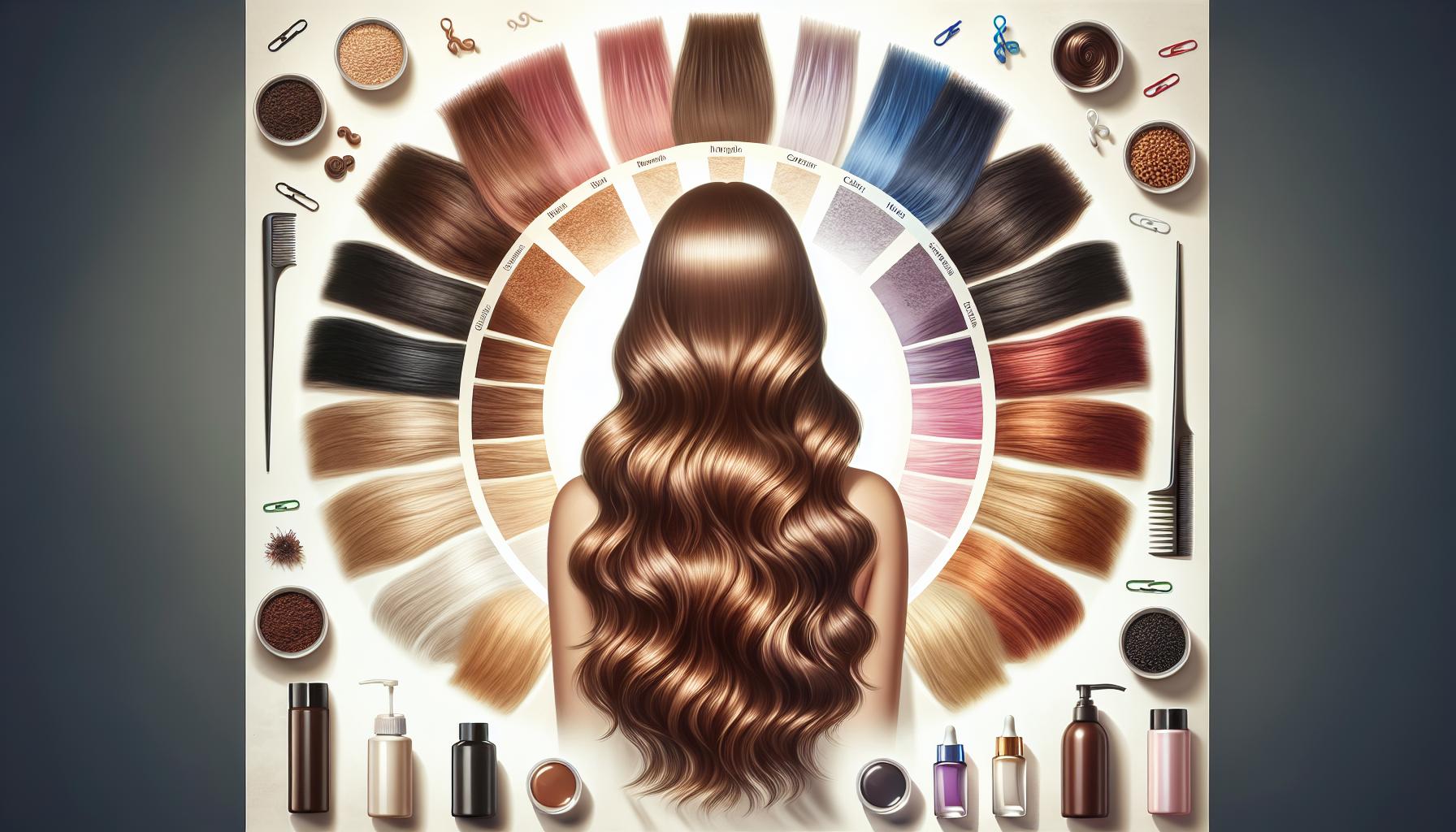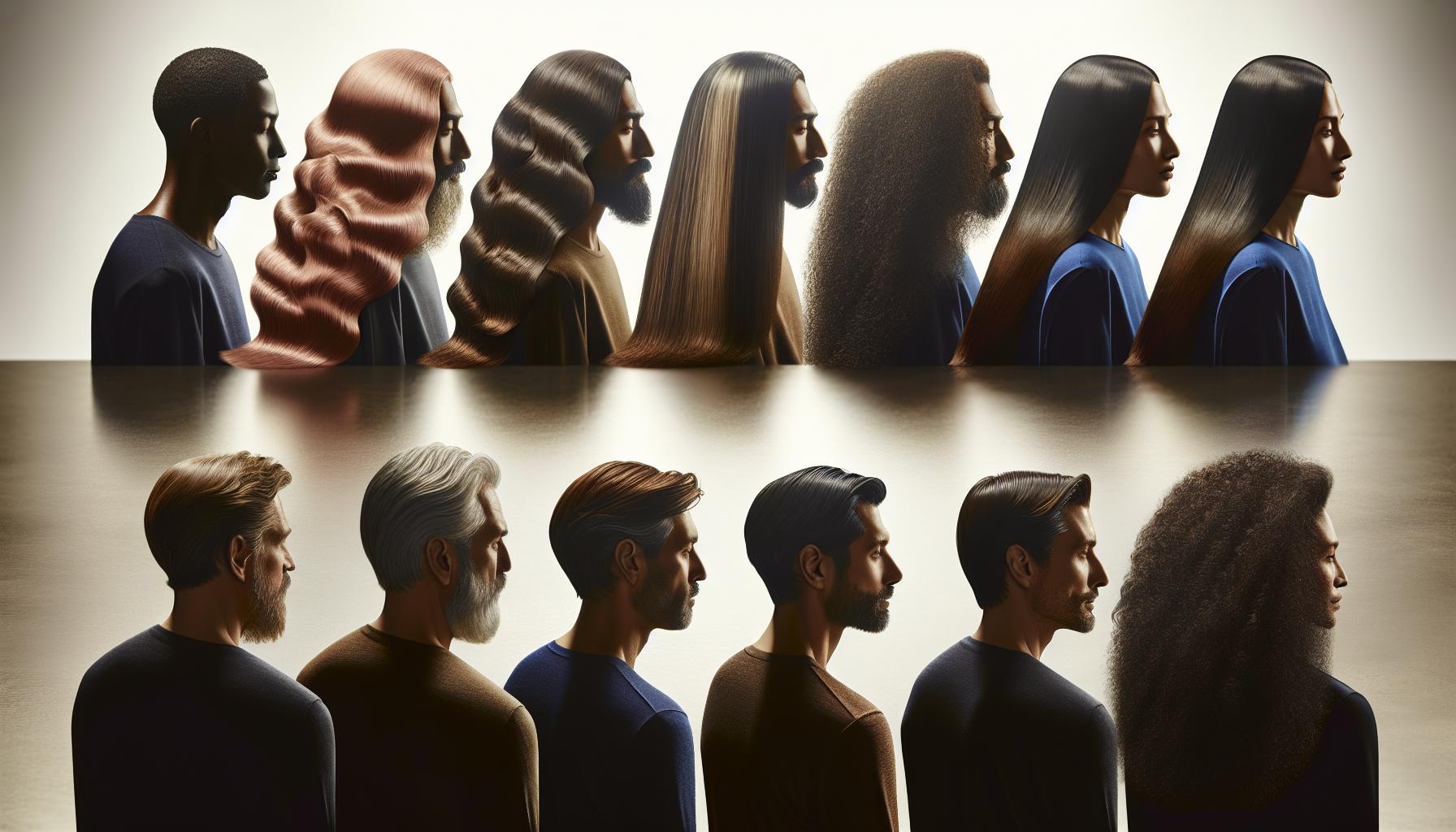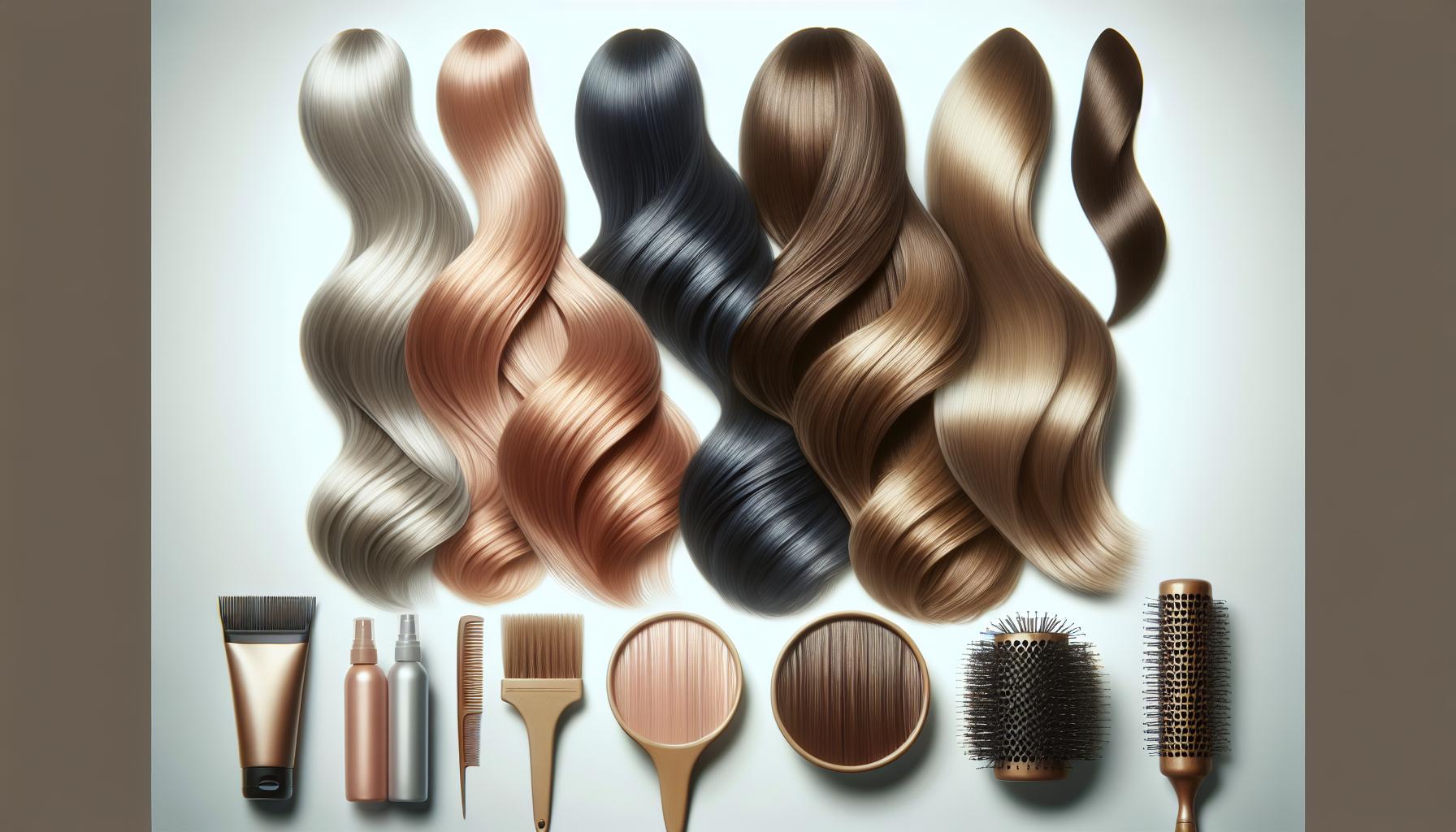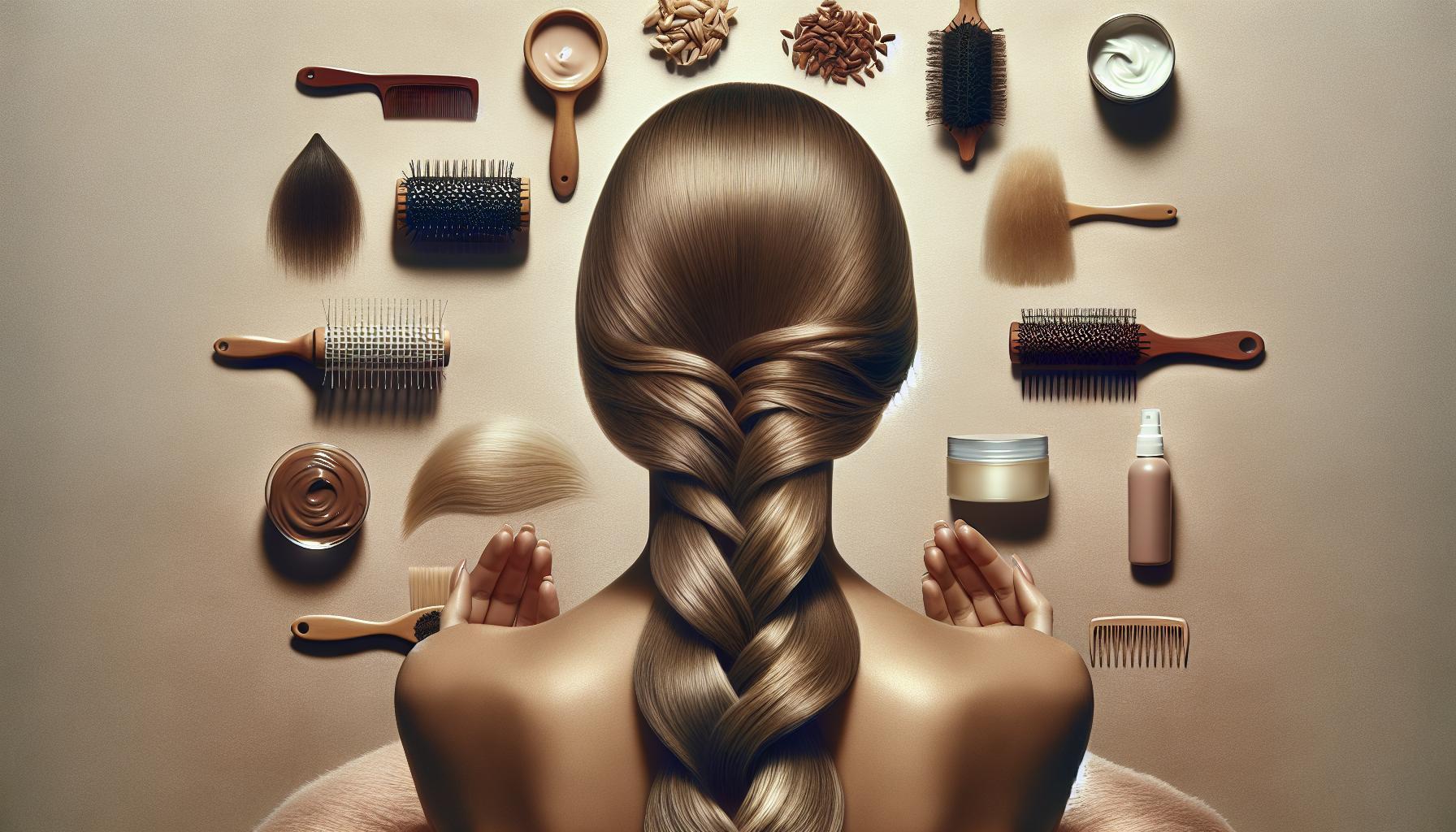Coloring your hair can be transformative, but many wonder, “Can I straighten my newly colored locks without causing damage?” Timing is crucial to maintaining the vibrancy adn health of your hair. This guide will unveil essential tips to ensure your strands remain beautiful and damage-free, even after your latest dye job.
Contents
- Understanding hair Chemistry: How Color Affects your Strands
- The Ideal Waiting Period: Timing your Straightening Post-Color
- Choosing the Right Tools: Minimizing Heat Damage After Dyeing
- Protective Measures: Preparing Your Hair for Straightening
- The Role of Professional Advice: When to Consult Your Stylist
- Aftercare Essentials: Nourishing Color-treated Hair
- Straightening Techniques: Safe Methods to consider
- Signs of Damage: Recognizing When to Avoid Heat Styling
- FAQ
- Can I straighten my hair after coloring?
- How long should I wait to straighten my hair after coloring?
- What are the best practices for straightening colored hair?
- Why does heat damage colored hair?
- Can I use any styling products after coloring my hair?
- how can I minimize damage when straightening my colored hair?
- What should I do if my hair feels damaged after coloring?
- The Way Forward
Understanding hair Chemistry: How Color Affects your Strands
Understanding the chemistry behind hair color is essential for anyone looking to maintain the health and vibrancy of their strands—especially after using chemical treatments.Hair is essentially a protein structure, and when you color it, you introduce various compounds that can alter its physical and chemical properties. This conversion poses questions such as, “Can I straighten my hair after coloring?”—and the answer is deeply tied to understanding how color interacts with your hair.
The Science of Hair Color
To fully grasp how color affects your hair, it’s crucial to recognize the role of pigments and chemicals in the dyeing process. Hair contains a natural pigment called melanin, wich comes in two types: eumelanin (brown/black) and pheomelanin (yellow/red). When you apply hair dye, you’re overriding this natural coloration. Here’s how it effectively works:
- Oxidative Dyes: These are common in permanent hair colors, where small dye molecules penetrate the cuticle and bond with the hair cortex. This method alters the hair structure,making it more porous.
- Direct Dyes: These sit on the outer layer of the hair, usually found in semi-permanent formulations, offering a temporary color change.
- Hydrogen Peroxide: Often used in conjunction with dyes, it lifts the cuticle and removes the natural pigment, allowing for color deposit.
Once hair is dyed, especially with oxidative dyes, it becomes more susceptible to damage from heat styling tools. This vulnerability raises an important concern: timing. If you’re considering straightening your hair post-coloring, understanding the right timing and conditioning techniques is critical to prevent damage.
Impact of Heat Styling
Applying heat tools to colored hair can cause various reactions depending on the type of dye used. As a notable example, when you directly straighten freshly dyed hair without allowing proper recovery time, you increase the risk of moisture loss and structural compromise. The table below outlines the optimal waiting times before applying heat:
| Type of Color | recommended Wait Time |
|---|---|
| Permanently Colored | 72 hours |
| Semi-Permanent | 24-48 hours |
| Direct Dyes | 12-24 hours |
By adhering to these timing secrets for zero damage, you can ensure that your hair maintains its integrity and shine. Don’t forget that after coloring, it’s crucial to use a reliable heat protectant before styling, as this forms a barrier between your hair and the heat source. Proper care not only enhances your colored hair but also allows you the freedom to explore different styles without compromising the health of your strands.
The Ideal Waiting Period: Timing your Straightening Post-Color
the relationship between hair color and styling techniques can be a bit delicate. If you’ve ever asked yourself whether it’s safe to straighten your hair after coloring, you’re not alone.Many people worry about the potential for damage during this crucial transition period. Understanding the ideal waiting time before you reach for your straightener can make all the difference in preserving your hair’s health and vibrancy.
### Why Timing Matters
When you color your hair,the cuticles are opened to allow the dye to penetrate. This process can leave your strands more susceptible to heat damage. If you use a flat iron too soon, you may risk compromising the integrity of your freshly colored hair. So, finding the right timing is essential for maintaining both color brilliance and hair health.
- Wait at least 48 hours: After coloring, give your hair at least two days to recover. This ensures the cuticles seal properly, locking in the dye.
- Allow for deep conditioning: In the days following your dye job, apply a good quality conditioner or a deep conditioning treatment to restore moisture.
- Do a heat test: If you’re eager to style, test the heat on a small, inconspicuous section of hair to gauge any immediate reactions.
### Ideal Timing Based on Hair Type
Different hair types may require different waiting periods. Here’s a simple guideline to help you decide:
| Hair Type | Recommended Waiting Period |
|---|---|
| Fine or Damaged Hair | 72 hours |
| Normal Hair | 48 hours |
| Coarse or Thick Hair | 24 hours |
Following these guidelines can definitely help you achieve sleek, straight hair without the risk of unintentional damage. By allowing your strands to rest and reap the benefits of conditioning treatments post-coloring, you not only enhance the longevity of your color but also prepare your hair for heat styling. always remember, the health of your hair should be your ultimate priority when considering the timing for straightening after coloring.
Choosing the Right Tools: Minimizing Heat Damage After Dyeing
When it comes to maintaining the vibrancy of your freshly dyed hair, the tools you choose to style it can make all the difference. Hair coloring can leave strands feeling dry and compromised, making it crucial to use the right implements that minimize further damage. Understanding how to select the appropriate heat styling tools is essential to achieving that sleek look while ensuring the health of your hair remains intact.
Key Tools for Minimizing Heat Damage
To effectively reduce the risk of heat damage after coloring, consider investing in high-quality tools that are designed with hair health in mind. Here are essential factors to look for when choosing styling equipment:
- material: Opt for tools made from ceramic or tourmaline, as they distribute heat more evenly, reducing the chance of localized damage.
- Heat Settings: Look for flat irons and curling wands that offer adjustable temperature controls. Lower temperatures are generally less damaging, especially for color-treated hair.
- Ion Technology: Tools that utilize negative ion technology help to lock in moisture and minimize frizz, promoting a healthier look.
- Protective Features: Some newer models come equipped with features like automatic shut-off or heat-resistant plates, which can enhance safety and reduce damage risk.
Recommended Tools and Techniques
For those wondering, “Can I straighten my hair after coloring?” the answer lies in your approach. For effective styling that preserves your hair’s integrity, consider the following recommendations:
| Tool | Benefit | Best Practice |
|---|---|---|
| Ceramic Flat Iron | Even heat distribution | use on low to medium setting, and always on dry hair |
| Tourmaline Curling Wand | Reduced frizz and static | Limit exposure time per section and curl with medium to low heat |
| Heat Protectant spray | Shield hair from moisture loss | Apply generously before using heat tools |
Incorporating heat protectant sprays into your routine can add a layer of safety against heat damage. These products enhance your hair’s resilience, allowing you to enjoy styling without compromising on quality or health. By following these guidelines and selecting the right tools, you can confidently style your colored hair without the fear of irreversible damage. Remember, understanding the relationship between your styling methods and the health of your locks is pivotal in achieving that gorgeous, salon-fresh look!
Protective Measures: Preparing Your Hair for Straightening
In the pursuit of perfectly straight hair, ensuring optimal readiness is essential, especially after coloring. Many wonder, “Can I straighten my hair after coloring? Timing secrets for zero damage” point towards the necessity of a strategic approach. Preparing your hair before straightening can significantly reduce heat damage, protect its integrity, and maintain color vibrancy.
When your hair has recently been dyed, it becomes crucial to adopt protective measures that shield it from the high temperatures of styling tools. Start by incorporating a nourishing deep conditioning treatment into your routine at least 48 hours post-coloring. This will help replenish moisture and fortify the hair cuticle. Look for conditioners enriched with ingredients like argan oil or keratin, which can help to strengthen and soften your hair, making it more resilient to heat styling.
Key Steps for Hair Preparation
Before you reach for your straightener, consider these actionable steps that will enhance the health of your hair:
- Wash with Care: Use a sulfate-free shampoo that maintains color while gently cleansing your scalp and strands.
- Hydrate: Apply a leave-in conditioner or heat protectant spray generously to your damp hair. these products create a barrier against heat while locking in moisture.
- Detangle Gently: Use a wide-tooth comb to detangle your hair from the tips to the roots,preventing breakage.
- Blow-Dry Properly: If you blow-dry your hair before straightening, use a low heat setting and a round brush to smooth out your strands.
Utilizing these methods not only prepares your hair but also sets the stage for achieving that sleek look without compromising your hair health. As you contemplate the optimal timing for straightening post-color, remember that immediate straightening may exacerbate damage; allowing your hair to rest ensures longevity and vibrancy. Integrating such protective measures into your routine will pave the way for stunning,healthy straight hair that shines brilliantly.
The Role of Professional Advice: When to Consult Your Stylist
The journey into hair coloring often leaves many asking, “Can I straighten my hair after coloring?” While the excitement of vibrant shades can be enticing, it’s crucial to understand the timing and professional guidance needed to maintain hair health. Professional stylists are equipped with the knowledge and experience to help you navigate the post-coloring process, ensuring you achieve the look you desire without compromising the integrity of your hair.
Understanding Hair Health Post-Coloring
After coloring, your hair undergoes meaningful changes. The chemical processes involved can weaken the hair structure, making it more susceptible to damage from heat styling like straightening. Consulting with a stylist can help you determine when your hair is strong enough to handle additional treatments. Typically,it’s recommended to wait at least two weeks post-coloring before subjecting your hair to heat.Your stylist can assess the condition of your hair and give personalized advice based on its texture and the specific coloring products used.
When to Seek Professional Advice
Knowing when to reach out to your stylist can save you from unneeded damage. Here are some scenarios where professional advice is notably beneficial:
- Immediately After Coloring: If you have any doubts about how your hair feels or looks after a coloring session, a consultation can provide clarity and direction.
- Experiencing Damage: If you notice signs of breakage, dryness, or frizz in your hair, it’s time to book a salon appointment for a deep conditioning treatment and expert evaluation.
- A Significant Change in Color: Major color changes (e.g., going from dark to light) can weaken hair significantly.A stylist can recommend a safe timeline for heat styling.
- Planning to Use Heat Tools: Before you plan to use flat irons or curling wands, consulting with a stylist can ensure your hair is ready.
Real-World Example: The Professional’s Touch
Consider the case of Sarah, who recently transformed her brunette locks to a daring shade of platinum. Eager to flaunt her new color, she wondered if she could straighten her hair immediately. By scheduling a follow-up with her stylist, she learned that her hair needed additional moisture to recover from the coloring process. Under her stylist’s guidance, Sarah waited two weeks, allowing her hair to regain strength. By the time she straightened her hair, she was thrilled to see not only a sleek finish but also vibrant, healthy-looking color.
Always remember, the key to stunning hair post-coloring lies in patience and the wisdom of professional advice.Understanding when to consult your stylist can empower you with the knowledge needed to protect your hair while achieving your desired style.
Aftercare Essentials: Nourishing Color-treated Hair
Color-treated hair requires dedicated aftercare to maintain its vibrancy and health. Post-coloring, the hair’s structure can be more susceptible to damage, making it crucial to choose the right products and practices to nourish and protect your strands. When considering if you can straighten your hair after coloring, understanding how to care for your newly colored locks is essential for ensuring they remain healthy and radiant.
Key Aftercare Products
to keep your hair vibrant and strong, selecting the right products is essential. Here’s a lineup of must-have items for nourishing color-treated hair:
- Color-Safe Shampoo and Conditioner: Opt for sulfate-free products designed specifically for colored hair to avoid stripping color and moisture.
- Deep Conditioning Treatments: incorporate a weekly deep conditioner or hair mask to replenish moisture, especially after using heat styling tools.
- Leave-In Conditioner: Use a leave-in product for added hydration and protection against environmental stressors.
- Heat Protectant Spray: If you decide to straighten your hair, always apply a heat protectant to shield your strands from thermal damage.
Daily Care Routine
Establishing a daily routine tailored for color-treated hair can make all the difference. Here are practical steps you can take:
- Limit Heat Exposure: While you may wonder, “Can I straighten my hair after coloring?” it’s best to wait a few days post-coloring before applying heat. On days you do style, keep the temperature low and use heat tools sparingly.
- Gentle Brushing: Use a wide-tooth comb or a brush designed for color-treated hair to minimize breakage during detangling.
- Avoid Over-washing: Washing too frequently can lead to color fading. Aim to wash your hair 2-3 times a week, using dry shampoo in between to refresh your roots.
Caring for Your Hair Post-Straightening
If you choose to straighten your hair after coloring, post-styling care is just as critically important. Consider these tips:
- Moisturize After Styling: Use a lightweight serum or oil to tame frizz and add shine without weighing your hair down.
- Monitor Your Hair’s Condition: Keep an eye out for signs of damage, such as brittleness or split ends, and adjust your routine accordingly. Regular trims can also help maintain healthy-looking ends.
| Signs of Damage | Suggested Remedies |
|---|---|
| Brittle Strands | Increase deep conditioning treatments. |
| Faded Color | Use color-depositing shampoos or conditioners. |
| Split Ends | Schedule regular trims every 6-8 weeks. |
caring for color-treated hair isn’t just about using the right products; it’s about understanding how to best maintain its health while allowing for styling options. With the right care and consideration, you can enjoy beautiful, vibrant hair while still indulging in your styling preferences.
Straightening Techniques: Safe Methods to consider
When it comes to styling freshly colored hair, many people wonder about the safest ways to achieve a sleek, straight look without compromising the integrity of their new hues. The question,“Can I straighten my hair after coloring? Timing secrets for zero damage,” often emerges,highlighting the concern regarding heat exposure on treated hair. Choosing the right techniques and tools can make all the difference, as certain methods can damage your locks while others can enhance their appearance.
Heat Protection is Key
Before diving into straightening methods, it’s essential to prepare your hair to tolerate heat. This involves using a quality heat protectant spray or serum that shields your strands from high temperatures and helps lock in moisture. Here’s how to effectively incorporate a heat protectant:
- Choose Wisely: Look for products that contain silicones or natural oils like argan oil or coconut oil.
- Request: Apply the protectant evenly on damp hair before blow-drying or straightening.
- Layering: for added security, apply a small amount of the protectant again after styling.
Alternatives to Conventional Flat Irons
If you wont to play it safe while still achieving beautifully straight hair, consider choice straightening techniques that reduce heat exposure:
- Blow Drying: Use a round brush and a blow dryer on a low heat setting. This technique can straighten your hair while minimizing heat damage.
- Heatless Methods: Techniques such as braiding your hair when it’s damp or using a velvet or fabric hair wrap can definitely help create straight styles without any heat.
- Steam treatments: Utilization of a steam flat iron allows you to hydrate your hair simultaneously while straightening, which can be less harmful than traditional methods.
DIY Straightening Masks
Incorporating DIY masks into your hair care routine can also protect your hair while keeping it manageable. Here’s a simple recipe to help smooth your strands:
| Ingredients | Benefits |
|---|---|
| 1 Banana | Natural moisturizer that promotes smoothness |
| 2 tbsp Honey | Seals moisture and combats frizz |
| 2 tbsp Olive Oil | Strengthens and nourishes the hair |
To apply, mash the banana and mix it with honey and olive oil. Apply this mask to your hair for 30 minutes, than rinse thoroughly. This not only helps in straightening but also enhances shine and softness, thereby addressing the core concern of styling colored hair without damage.
By employing these straightening techniques and being mindful of the potential risks involved, you can confidently navigate the question of whether you can straighten your hair after coloring. Embracing safe methods ensures your vibrant color remains intact while you rock those sleek styles!
Signs of Damage: Recognizing When to Avoid Heat Styling
It’s frequently enough assumed that a fabulous new hair color can only be enjoyed with a perfectly sleek finish.however, many enthusiasts may ask themselves, “Can I straighten my hair after coloring?” while unknowingly overlooking vital signs of damage that could signal it’s time to take a break from heat styling. Recognizing these indicators early can prevent irreversible harm and ensure your locks remain healthy and vibrant.
Visible Signs of Stress
After coloring,your hair may exhibit various visible symptoms of damage. Here are crucial indicators to consider:
- dullness: If your hair appears lackluster and no longer reflects light as it used to, this is a tell-tale sign of damage.
- Split Ends: Frequent heat exposure can exacerbate split ends, making them more pronounced. Regular checks can help you spot this issue early.
- Brittleness: If your hair snaps easily during brushing or styling, it might be time to give the heat tools a rest.
- Unmanageable frizz: While humidity plays a role,excessive frizz combined with your recent color treatment suggests your hair may need extra TLC.
Texture and Elasticity Changes
Another critical factor to consider is the texture and elasticity of your hair. Healthy hair should possess some degree of elasticity, allowing it to stretch without breaking. After coloring, if your hair feels dry or breaks easily when styled, it’s a clear signal to step away from that straightener.
To gauge your hair’s elasticity, you can perform a simple water test:
| Step | Description |
|---|---|
| 1 | Take a strand of clean, dry hair. |
| 2 | Soak the strand in water for a few minutes. |
| 3 | Gently pull the strand. If it stretches and returns to its original length, your hair is healthy. If it breaks or doesn’t return, it’s overstressed. |
Recognizing these signs is paramount for anyone pondering “Can I straighten my hair after coloring?” Timing your styling routines and ensuring your hair is adequately prepped will save you from further damage.Always prioritize health over aesthetics, and remember that your hair deserves the best possible care post-color treatment.
FAQ
Can I straighten my hair after coloring?
Yes, you can straighten your hair after coloring, but timing is crucial for zero damage. It’s advisable to wait at least 72 hours after the coloring process to allow the cuticles to close and minimize any potential damage.
When you color your hair, the strands are more porous and susceptible to damage. Waiting a few days helps to restore your hair’s natural barrier, enhancing its ability to withstand heat styling. Always use a heat protectant spray before straightening for added protection.
How long should I wait to straighten my hair after coloring?
After coloring your hair,it’s best to wait at least 72 hours before straightening. This gives your hair enough time to recover from the chemical process and regain its natural moisture.
Immediate heat styling can lead to increased dryness and damage, particularly if you use high heat settings. It’s also a good idea to monitor your hair’s condition in the days following coloring. If you notice excessive dryness, consider waiting longer before using heat tools.
What are the best practices for straightening colored hair?
To achieve the best results when straightening colored hair, use a low to medium heat setting and always apply a heat protectant. Opt for products that specifically mention being safe for colored hair to protect against fading.
Using high-quality tools can make a significant difference. Look for flat irons equipped with ceramic plates as these distribute heat more evenly, reducing the risk of damage.Consider a deep conditioning treatment after straightening to help maintain moisture and vibrancy.
Why does heat damage colored hair?
Heat can cause damage to colored hair as it strips away moisture and affects the protective layer of the hair cuticle. Damaged cuticles can lead to breakage and loss of color vibrancy.
The coloring process often makes hair more porous, which in turn makes it more vulnerable to heat. It’s essential to be mindful of the temperature and the time spent exposing your hair to heat styling tools.
Can I use any styling products after coloring my hair?
It’s wise to choose styling products specifically designed for colored hair to maintain both color and health. Look for products that are sulfate-free and contain nourishing ingredients.
Avoid products with high alcohol content, as they can further dry out your color-treated hair. Instead,aim for moisturizing serums or creams that enhance shine and minimize frizz while protecting your color.
how can I minimize damage when straightening my colored hair?
To minimize damage when straightening colored hair, always use a heat protectant and keep the straightener on a lower setting. Avoid going over the same section multiple times, which can lead to overheating.
Additionally, ensure your hair is wholly dry before using heat tools, as wet hair is more prone to heat damage. Regular deep conditioning treatments can also help maintain your hair’s integrity.
What should I do if my hair feels damaged after coloring?
If your hair feels damaged after coloring, focus on deep conditioning treatments and avoid further chemical processes. Look for protein-rich and moisture-infusing hair masks that can definitely help restore your hair’s health.
Regular trims can help remove split ends,and be gentle with your hair while washing and styling.You can find more tips in our detailed guide on hair care management.
The Way Forward
the informed approach to straightening your hair after coloring is essential for maintaining its health and vitality. By prioritizing the timing and techniques used, and also incorporating nourishing products, you can achieve beautiful, straight styles without incurring damage. Remember, patience is key—allow your hair the necessary time to recover from the coloring process before introducing heat styling. This not only prevents breakage but also enhances your overall hair appearance.
As you navigate your hair care journey, consider incorporating hydrating masks and heat protectants into your routine to further safeguard your strands. For ongoing support and tips tailored to your specific hair type, don’t hesitate to explore more articles on hair health and styling techniques. Your hair deserves the best, and taking these steps will empower you to enjoy both vibrant colors and stunning straight styles with confidence!

